WHAT'S NEW:
Eruption Confirmed!
New lava (rumbleometer stuck in flow) SE rift zone
(posted 9/1/98)
BACKGROUND:
Technology (ROV, ships, etc.)
Other 1998 Axial cruise reports
EXPEDITION:
Science Objectives
Calendar
Today's Science News
Participant Perspective
Teacher Logbook
EDUCATION:
Curriculum
Teacher Observations
Questions/Answers from sea
MULTIMEDIA:
(video clips, animations, sounds)
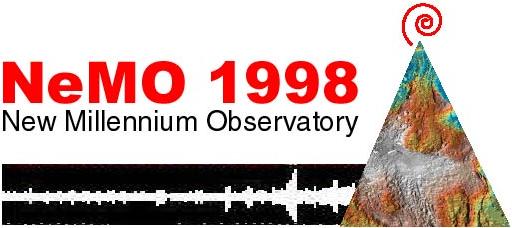
Logbook
September 14, 1998
September 14, 1998
Contents:
Science Report
Daily Science Report - Sep 14
ship's location = 45 56.0N/129 58.9W
ROPOS underwent some maintenance work for much of today. The tether that goes between ROPOS and its cage needed to be re-terminated (a process in which a new end is cut in the tether and it is rewired into ROPOS) and a host of other minor problems were corrected. After dinner ROPOS descended for dive 477 and the first task was phase 2 of the rumbleometer recovery. This involved attaching a line from the cage to the rumbleometer and pulling the cage up until either the rumbleometer came off the seafloor, or the line broke. If the instrument came off the seafloor and let go of its anchor, then it would be buoyant and immediately start rising toward the surface. To prevent it from slamming into the cage, we had attached a line and weights to it a few days ago during dive 474. Ideally it would be floating above the bottom attached to that "anchor" line after we pulled it out of the new lava flow. Then the cage could drop the "pull" line and ROPOS could cut the "anchor" line and let it float up to the surface to be recovered by the ship.
Unfortunately that didn't happen. The "pull" line we attached today had a "weak link" in it that would break if the cage pulled with over 2200 pounds of force (so that we wouldn't risk being anchored to the seafloor if anything went wrong). After only a few minutes of pulling up with the cage the weak link broke. When ROPOS went back down to the bottom, the rumbleometer had not budged, even though we had pulled with 3-4 times its weight with its anchor attached (about 600 pounds in water). That thing is really stuck! There were a lot of disappointed faces in the ROPOS control room after this latest rescue attempt. We now have to consider other more complicated options and whether or not we could fit such an operation into the rapidly diminishing time we have out here.
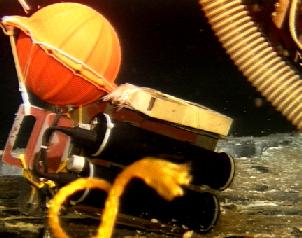 In the meantime, ROPOS has moved onto other tasks in dive 477, including
recovering
a short-term OSMO sampler, deploying a long-term OSMO sampler, and recovering
bacterial traps. The OSMO samplers are ingeneous devices (see photo left)
designed to collect small
volumes of vent fluid continuously over a long period of time, so that a time
series of
samples is obtained, even after ROPOS is long-gone (most fluid sampling is only
done
when an ROV or sub is at a specific site). These long-term samplers will stay
out for a
year and then will be recovered for chemical analysis.
In the meantime, ROPOS has moved onto other tasks in dive 477, including
recovering
a short-term OSMO sampler, deploying a long-term OSMO sampler, and recovering
bacterial traps. The OSMO samplers are ingeneous devices (see photo left)
designed to collect small
volumes of vent fluid continuously over a long period of time, so that a time
series of
samples is obtained, even after ROPOS is long-gone (most fluid sampling is only
done
when an ROV or sub is at a specific site). These long-term samplers will stay
out for a
year and then will be recovered for chemical analysis.
Listing of all Science News postings
Life at Sea: Participant Perspective
Keith Tamburri - Vice President DTEC. Ltd.
Partner in small business that provides electronic equipment and services for Remotely Operated Vehicles worldwide.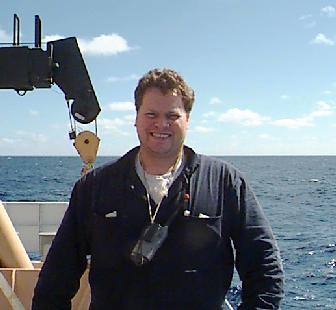
My background with ROV 's goes way back 16 years ago when I was 15 and took a weekend job to paint the floors in the shop that built ROPOS, International Submarine Engineering. From that weekend, aside from a few other small jobs, I've been in the ROV business. I attended a technical college a few years after graduating high-school and received a diploma in Robotics and Automation. My career has varied from designing complete ROV systems in the office to the operational management and supervision of these systems off-shore, both commercial and scientific. I've been the night shift supervisor for the ROPOS system for 5 years and have enjoyed this position with the ROPOS team. ROPOS, as do most ROV's , has a "personality" and must be treated in a certain way, and we seem to have synchronized over the last few years. The last two scientific cruises of the summer have provided scientists with a wealth of data, samples and video never provided before by a ROPOS cruise. With the system refinements over the years to the sub-sea navigation, cage and vehicle systems, the ROPOS platform has proven itself as a viable scientific tool.
Coming from the commercial ROV offshore world to work with the scientific ROV offshore world has been a welcome change from driving kilometers of sub-sea fibre optic telephone cable or pipeline to discovering new species of clams, crabs, worms, etc.. The operational management differences between commercial and scientific ROV cruises are quite different due to the specific nature of the dives on a scientific cruise. Each dive is planned with a certain amount of equipment on the ROV and when all the tasks of that dive have been accomplished, the ROV is recovered and re-configured for the next dive. During this period maintenance to the ROV can also be performed. In comparison, when working on a commercial job the ROV is recovered only to perform maintenance, re-rig equipment, or when the job is completed and you can go home. This cruise in particular has proven the diversity of ROPOS as seen though the pages of this web site.
Working night-shift has its benefits. Usually the room will clear out, with the exception of the scheduled watch workers and scientists who have tasks to be performed on the dive . Some of the scientists work the day-shift and on into the night shift. The room can become full of laughter quite easily as the midnight giggles set in. It's very easy to be a comedian on the night shift. After the laughter period subsides, the silence and calm of the early morning set in. Some actually start "head-bobbing" in the chief scientist's chair, only to be awakened by the cry of "PHOTO!!!" from the pilot.
Listing of all Perspectives postings
Teacher At Sea Logbook
September 14 - 0900 hours
Despite dire predictions the weather remains calm and sunny this morning. The
seas are not as large as they were yesterday. That is a pleasant surprise.
There is, however, a fly in the ointment. The "Big R" is upon us, or at least a
mild version of the "BIG R" Retermination. The tether that connects ROPOS to
the ship has developed problems that require the technicians to reconnect
(reterminate) each of the wires that power the system. Fortunately this does
not include the data-transmitting fiber optic system. If the fiber optics are
damaged the retermination can take in excess of 24 hours. This project which
will include testing of the sub's systems before re-deployment, will cause
approximately a six hour delay. The science team met Sunday evening to rough
out the plans for the rest of our dive time. This is done to be sure that a
maximum of work is completed and that every scientist gets input as to which
projects are most significant. In addition, dives can be planned to maximize
data retrieval, sample collection, and deployment of equipment during the last
week at sea. The problems with ROPOS will mean another meeting after lunch
today to adjust those remaining dives.

There are many things the scientists would like to do before Friday. Dr. Tunnicliffe wants to place a camera system along side one of the biologically active vent sites. The camera is programmed to take one picture each day for a year. The camera sled will be retrieved next year, and when the film is developed she will have a "time-lapse" picture of the growth of organisms and changes in the populations around the vent. (photo left) The geologists are intent on retrieving the data from the rumbleometer that appears to be stuck in the new lava flow. A new anchor has been attached to the rumbleometer. On our next dive a cable with a weak link will be attached from the ROPOS cage to the rumbleometer. With ROPOS standing off at a safe distance, the cage will be used to pull the instrument free of the sea floor. If it is stuck too tight the weak link will separate and the attempt will be abandoned. If the rumbleometer breaks loose and begins to rise toward the surface, it will be held by the new anchor. This will prevent it from colliding with and perhaps damaging the cage. Later, with the cage out of harm's way, ROPOS sill cut the tether and allow the rumbleometer to float to the surface where it can be recovered.
Additional goals for the remaining dives include deployment of a chemical sampler called an "osmosampler" that will remain on the ocean floor to collect data until a later cruise recovers it. Pursuing a better understanding of vent chemistry, SUAVE will be sampling along east to west transits of the vent region. A site will be selected for re-deploying the extensometers. The data has been downloaded from these instruments, They have been cleaned, greased, and supplied with at least a year's worth of new batteries. They will also be left behind on the ocean floor.
| I want to finish today's report with something of a mystery. Several of the college students brought styrofoam heads aboard the ship, and for the first couple of weeks, spent some spare time decorating them. (See "Before" photo) This "Before" picture shows the decorated heads sitting on the counter next to the incubator in the biology lab. The "After" picture shows the same heads after. . .after what? That is the mystery. What do you think caused the change in the heads? The answer later this week. |
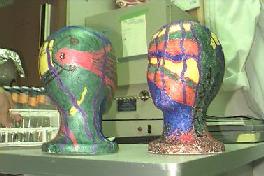
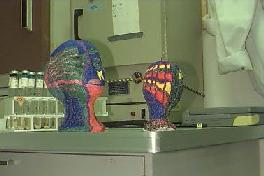
|
Logbook of all Teacher At Sea postings
Question/Answer of the Day
Send Your Question to NeMO
(oar.pmel.vents.webmaster@noaa.gov)
Back to Calendar